How to Make Your Own Non-Toxic Foaming Hand Soap
This post may contain affiliate or sponsored links. Please read our disclosure policy.
Why Wait?
Seriously…why did I wait so long to do this? For years I’ve either been buying way over-priced safe hand soap or cheap unsafe soap. Those days are over.
This past weekend, I used three simple ingredients to make my own non-toxic foaming hand wash. It is the perfect consistency, smell, and price! Read on to find out:
- why regular hand soap is unsafe
- what supplies you’ll need to make your own non-toxic foaming hand soap
- how to make non-toxic foaming hand soap in about 5 minutes
- and how much money I saved!
What Makes Regular Hand Soap Unsafe?
From commons allergens and skin irritants to chemicals that are known to cause brain damage in rats, most soap on store shelves is full of ingredients that can be both harmful to our bodies and our environment.
The great thing about my non-toxic foaming hand soap “recipe” below is that you don’t have to worry about exposing you and your family to any of the unsafe chemicals in store-bought soaps ever again!
Supplies You’ll Need To Make Your Own Hand Soap
You’ll need three simple ingredients (only 2 if you don’t want scented soap) plus foaming soap dispensers.
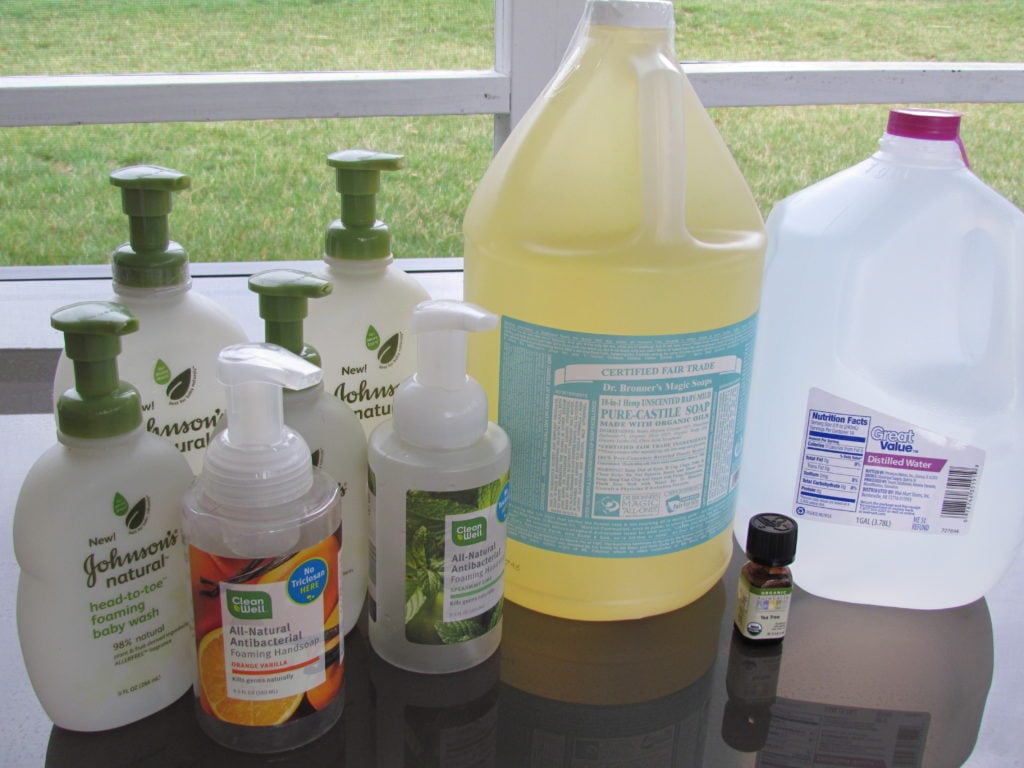
The supplies I recommend using are an upfront investment but will save you money in the long run, as you’ll see at the end of this post.
1 – Distilled or purified water – About $1/gallon at Walmart in bottled water aisle. This kind of water has had many of it’s impurities removed.
2 – Dr. Bronner – Castille Soap, liquid – I bought the unscented, mild formula since I figured it is the gentlest on our skin, and we are using it on our kids in the tub. Check out how simple and recognizable the ingredient list is: Water, Saponified Organic Coconut & Olive oils (w/ retained Glycerin), Organic Hemp Oil, Organic Jojoba Oil, Citric Acid, Vitamin E.
3 – Optional: Tea tree oil (or your favorite essential oil) – Tea tree oil not only adds a fresh, clean scent, but it also lends natural anti-bacterial qualities to the soap.
4 – Foaming Soap Dispensers – I just used empty ones I had previously purchased.
5 – Optional: A funnel – You don’t have to have one, but it helps cut down on potential mess.
How to Make Non-Toxic Foaming Hand Soap
Step 1: Pour enough castile soap in bottle to fill it about 1/5 of the way full. For a 9 oz bottle, I put in roughly 2 fl oz. I just eye-balled it.
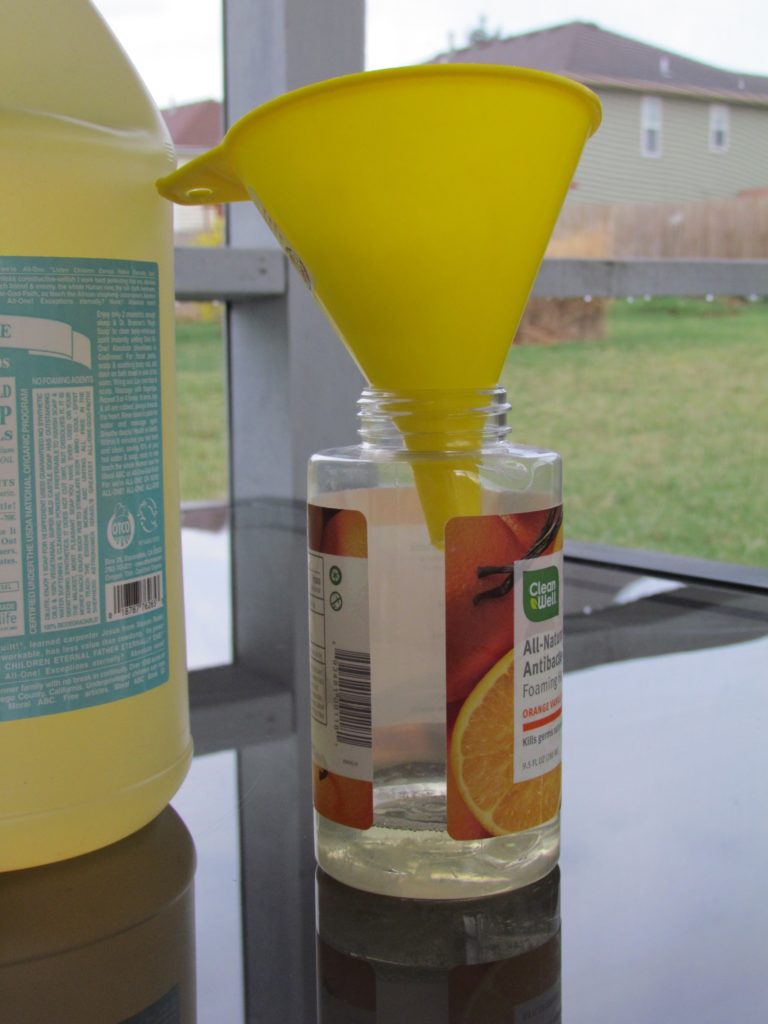
Step 2: Fill the rest of the bottle to the fill line or almost to the top with the water.
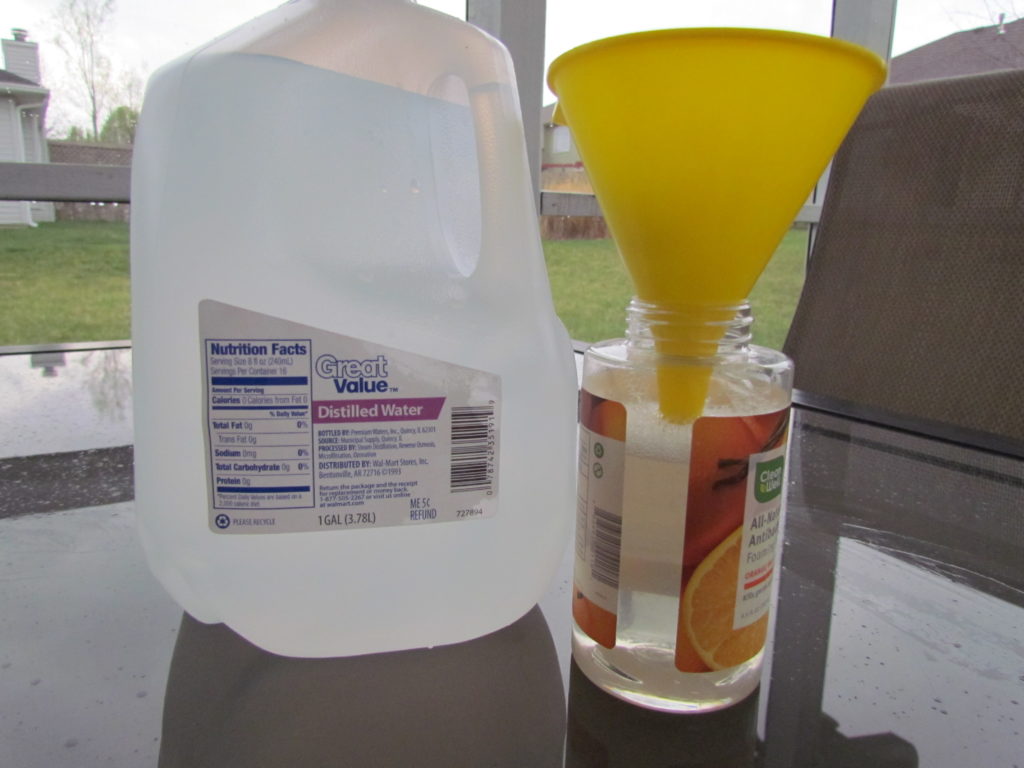
Step 3: Add 1-2 drops of tea tree oil (or your favorite essential oil). Don’t go too crazy, though, since it has a strong scent. Note: If you have sensitive skin, you may want to skip this step.
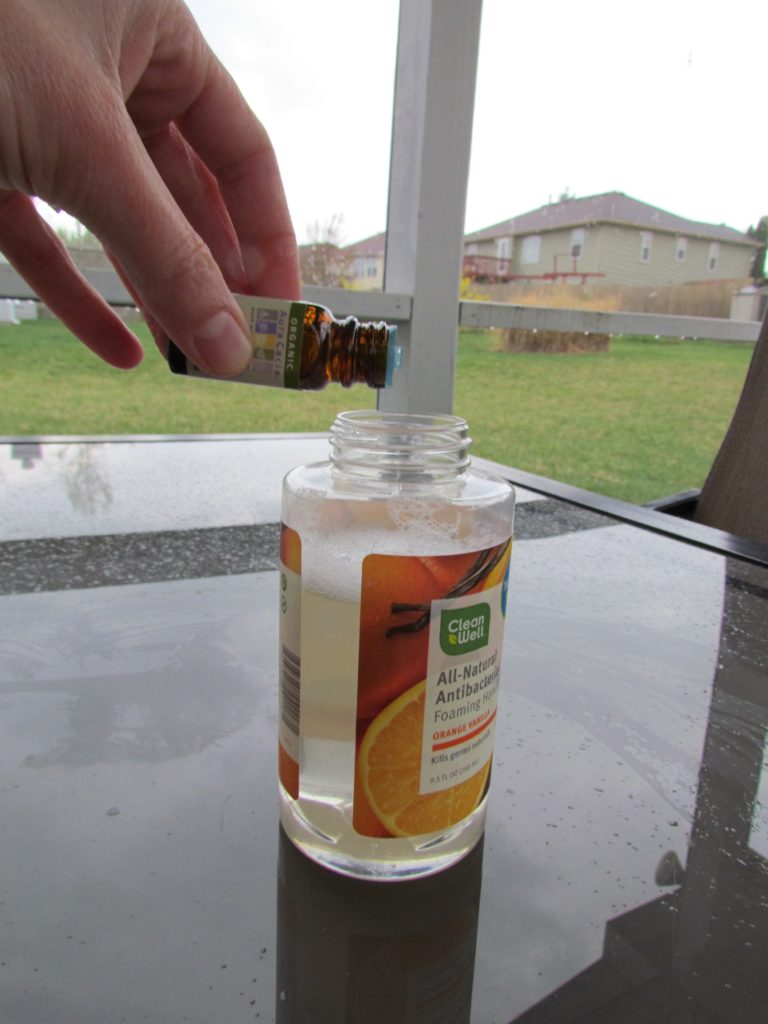
Step 4: Screw on the lid and give a little shake.
Step 5: Wash hands and enjoy the fresh smell and feel of clean hands!
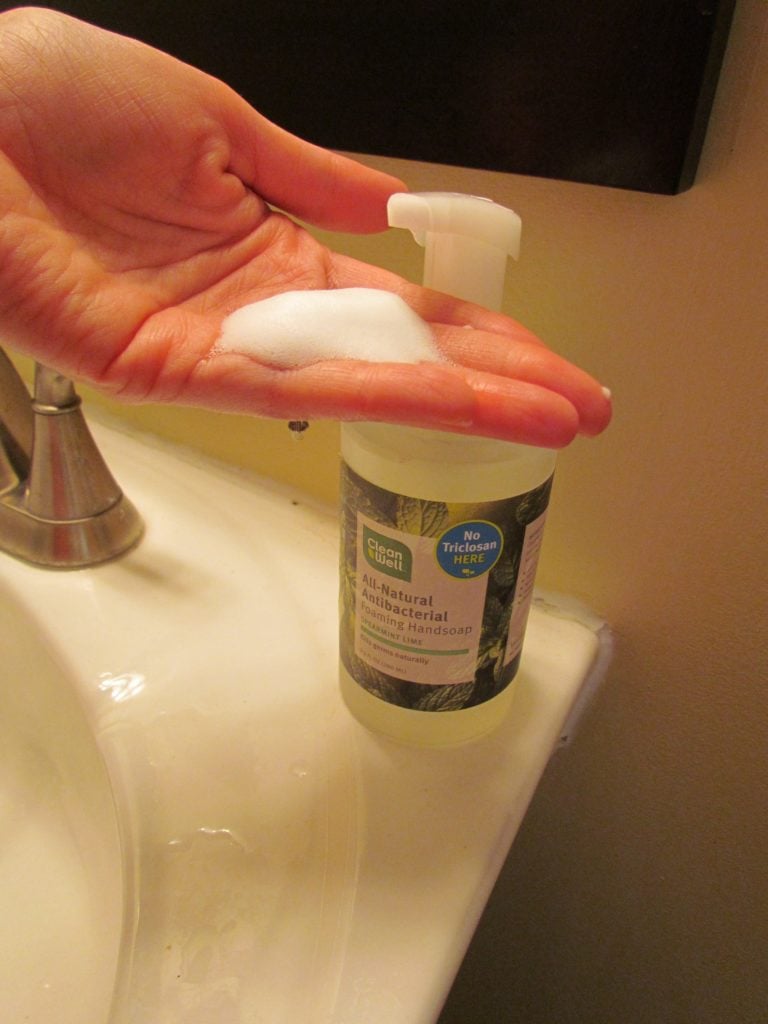
How Much Money Did I Save on My Foaming Hand Soap?
Here are my finished products–six dispensers with a total of 73 fl oz of foaming hand soap–that took about five minutes to make. Want to see how much money I saved?
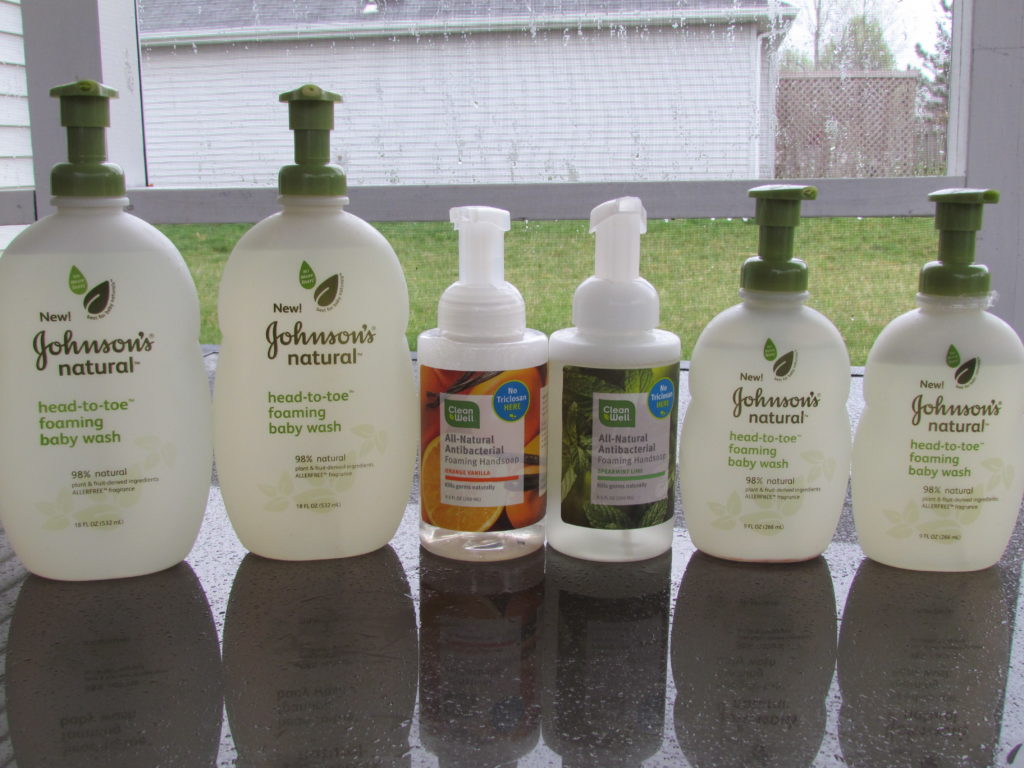
Here’s the cost of the original safe store-bought soaps:
Johnson’s Baby Natural Wash (9 oz): $4.49 x 2 = $8.98
Johnson’s Baby Natural Head-to-toe Wash (18 oz): $7.79 x 2 = $15.58
Clean & Well All Natural Antibacterial Foaming Hand Soap (9.5 oz): $4.33 each x 2 = $8.66
Store-Bought Safe Soap Total = $33.22 ($.46/fl oz)
Here’s the cost of my homemade non-toxic foaming hand wash in the same containers:
9 oz containers: $.90 x 2 = $1.80
18 oz containers: $1.55 x 2 = $3.10
9.5 oz containers: $90 x 2 = $1.80
Homemade Non-Toxic Soap Total = $6.70 ($.09/fl oz)
TOTAL SAVINGS BY MAKING MY OWN = $26.52!!!!!!
Like this DIY all-natural household product? Try this thrifty, non-toxic solution that’s worked for us…
All-Natural DIY Drano – Naturally unclogs your toilet or any drain with only 2 ingredients!

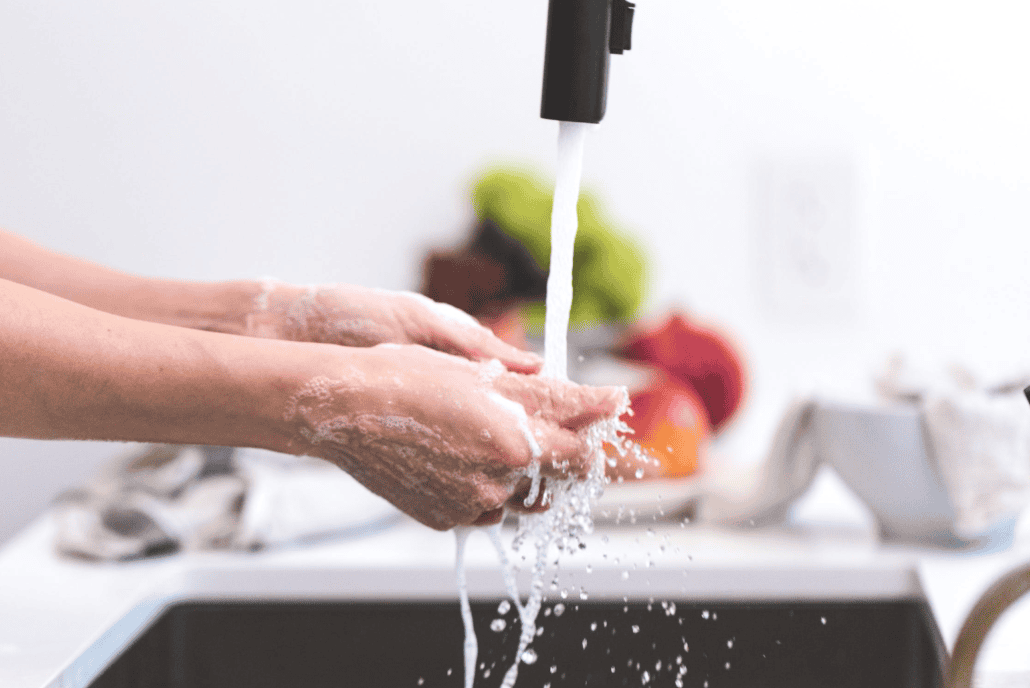
Have you found that this soap dries out your skin? I love everything about it except the drying factor! My hands already dry (to the point of cracking and bleeding in the winter dry air, and washing tends to make it worse) so I waited to test this soap recipe until now that the weather’s quite warm and humid and my hands are as soft as they ever get. On the first wash, they immediately felt drier and the skin felt tighter. I actually washed again right after in a store-bought version of foaming soap just so they would be moisturized again. Have to apply lotion, too. I LOVE this idea and really want to make it work. I am a special education teacher and would love for my students to make this soap to sell as a vocational activity…but I definitely want to troubleshoot first! Any suggestions for combating the drying aspect of the castile soap? (On my test batch, I did add more than the suggested amount of oils, so I’m guessing that would not be an effective solution.)
Thanks in advance for any help! I really want to make this work!
Hi Kara,
I have dry hands too, but I’ve used this soap for so many years that I guess I never really noticed if that was the culprit. I was thinking about your question and I wonder if adding some jojoba oil would help? It’s all natural and I use it in my kids’ baths sometimes to help keep their skin moisturized in the winter. Does anyone else have thoughts?
sometimes our hands smell sour (almost like vomit) after we use the soap. I used exactly what you suggested. Do you think my ratio is wrong, or does the soap expire?
Ewww, that’s gross. I’m not sure what to say. I’ve never ever had that happen and I’ve had a big Bronner’s bottle on my shelf for a long time for refills. Is it possible you ordered a scent you didn’t like? Or did you use an essential oil in it that smells weird? Sorry!
Diluting castile soap like this greatly reduces its natural preservative properties; without adding additional preservative, you will have an unsafe level of bacterial growth in your foaming soap within 2-3 weeks.
Thanks for your comment. Would you mind sharing your source for this? Every recipe I’ve found online is very similar to ours and I’ve used this for years.
Dr. Bronners does not work with my very hard water. It makes an awful film that is next to impossible to clean. Any substitutions?
Not that I know, but I’d love to find another option too. I’ve seen the film you’re talking about. Baking soda works to remove it.
Oh my gosh,
I have to try this right now. I was reading about Dr. Broner online the other day and he sounds like a very cool guy.
Thanks for sharing your recipe.
Elise
Does it have to be a foaming dispenser?
Yes, it does or else you end up basically squirting water on your hand (it won’t foam with a regular dispenser).
hello, I have a question about the foaming soap. I made a soap recipe very similiar to yoursbut my problem is that it is not foaming and is quite thin. I am using soap dispensers that had store bought foaming soap so am wondering what is wrong, Any help would be appreciated as I am going to be teaching children how to do this next week! Thank you!
Hi Marg,
I would guess two things, but it’s hard to tell. First, you may just need to add more soap to water ratio. The second thought is that perhaps you have the wrong kind of soap. The castile soap is very concentrated and is different than regular hand soap you buy at the store. I hope that helps.
Rachel
Thanks Rachel, I am going to try a different soap pump. I used Dr. Bonner’s soap as we use that anyway. I will keep experimenting! I did try adding glycerine but that didn’t do anything. Thanks for getting back to me so quickly! I don’t mind that it doesn’t foam but am going to be making it with elementary children and they love the foaming! Great website that you have here! Marg from Canada!!:))
Yes, perhaps that is the issue. I don’t know if you have Target way up north, but their Method foaming soap brand has a dispenser that works well. Have fun making this with kids. My kiddos love to do this with me. Thanks for reading Thriving Home!
Rachel
Thanks, Jess. I just refilled mine this morning, too. It’s so much cheaper and better for us, too!
I do this at home with Dr. Bronners and everything! I feel great knowing that other people support the foaming soap idea with non-anti-bacterial soaps. Great tutorial with photos. Love it!
This is a great idea! Thanks for linking up to our “Strut Your Stuff Saturday.” We love having you and hope you’ll be back next week! -The Sisters
Thanks for including the savings math in your recipe. I’m not naturally crafty, so I need the motivation of saving money to get me going on a new DIY project…and that was a lot of savings! I just liked your Facebook page so I can keep up with your new ideas going forward. 😀
I love this idea! I will definitely have to give this a try as soon as I’m back in my house!
I would love for you to share this over at my “Unveil Your Genius” Link Party!
http://taylornorris.blogspot.com/2012/03/unveil-your-genius-link-party_22.html
Happy Friday!
Thanks so much for linking up! I hope you’ll link up again soon! 🙂
Now I just need to save up some bottles. All of mine are the regular Method ones and I doubt they’ll work. BTW – let me know if you try homemade laundry detergent. I bought the stuff like 6 months ago to make it and haven’t ever pulled the trigger. 🙁
Darcie, I’ve been doing it for about 3 years now. Let me know if you have questions!
Lets us know what you think when you get done with it!
As I made my third batch this morning, it occurred to me I’ve never posted about how much I LOVE this stuff!! So easy and great and cost-saving!
Have you tried an alternative to shaving cream? I am looking for one for my husband to switch to. Anyone tried this foaming handsoap recipe as an alternative to shaving foam? Thanks!
I haven’t found an alternative to shaving cream yet. But, this foaming handwash won’t do the trick, I’m afraid.
I am so trying this. I tried a different recipe on Pinterest and it was a total fail. I am looking forward to redeeming myself with this one:).